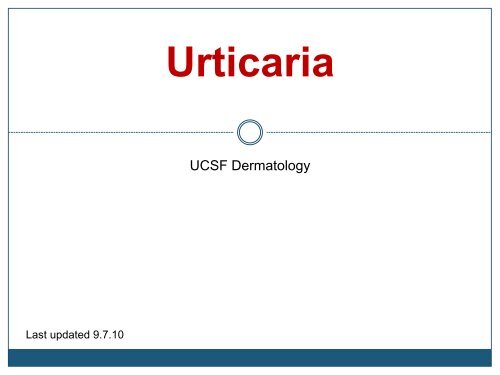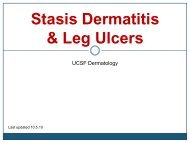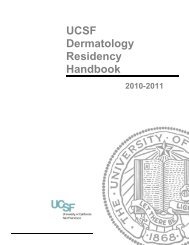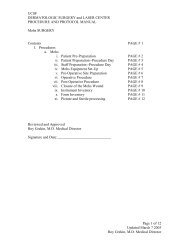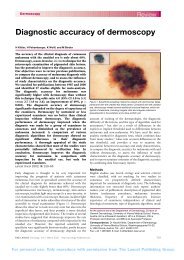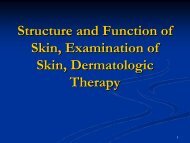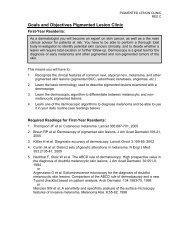Urticaria - Dermatology
Urticaria - Dermatology
Urticaria - Dermatology
You also want an ePaper? Increase the reach of your titles
YUMPU automatically turns print PDFs into web optimized ePapers that Google loves.
Last updated 9.7.10<br />
<strong>Urticaria</strong><br />
UCSF <strong>Dermatology</strong>
Module Instructions<br />
The following module contains a number of<br />
green, underlined terms which are<br />
hyperlinked to the dermatology glossary,<br />
an illustrated interactive guide to clinical<br />
dermatology and dermatopathology.<br />
We encourage the learner to read all the<br />
hyperlinked information.
Goals and Objectives<br />
The purpose of this module is to help medical<br />
students develop a clinical approach to the initial<br />
evaluation and treatment of patients with<br />
urticaria.<br />
After completing this module, the medical<br />
student will be able to:<br />
• Describe the morphology of urticaria<br />
• Distinguish between acute and chronic urticaria<br />
• Develop an initial treatment plan for a patient with acute or<br />
chronic urticaria<br />
• Distinguish between 1 st and 2 nd generation H1<br />
antihistamines with regard to sedation<br />
• Recognize the signs and symptoms of anaphylaxis<br />
• Discuss when to refer to a dermatologist
<strong>Urticaria</strong>: The Basics<br />
<strong>Urticaria</strong> (hives) is a vascular reaction of the skin<br />
characterized by wheals surrounded by a red halo or<br />
flare.<br />
• Cardinal symptom is PRURITUS (itch)<br />
Up to 20% of the population experience urticaria at<br />
some point in their lives<br />
Angioedema is caused by swelling of the<br />
subcutaneous tissue whereas urticaria is caused by<br />
swelling of the dermis<br />
Angioedema and/or urticaria may be the cutaneous<br />
presentation of anaphylaxis, so assessment of the<br />
respiratory and cardiovascular systems is vital!
<strong>Urticaria</strong>: The Basics<br />
Lesions typically appear over the course of<br />
minutes, enlarge and then disappear within<br />
hours<br />
Individual wheals rarely last >12hrs<br />
Surrounding erythema will blanch with pressure<br />
<strong>Urticaria</strong> may be acute or chronic<br />
• Acute = new onset urticaria < 6 weeks<br />
• Chronic = recurrent urticaria (most days) > 6 weeks<br />
Most urticaria is acute and resolves
Etiology of Chronic <strong>Urticaria</strong><br />
Idiopathic<br />
• Over 50% of chronic urticaria<br />
Physical urticarias<br />
• Many patients with chronic urticaria have physical factors that<br />
contribute to their urticaria<br />
• These factors include pressure, cold, heat, water (aquagenic),<br />
sunlight (solar), vibration, and exercise<br />
• Cholinergic urticaria is triggered by heat and emotion<br />
• The diagnosis of pure physical urticaria is made when the sole<br />
cause of a patient’s urticaria is a physical factor<br />
Chronic autoimmune<br />
• Possibly a third or more of patients with chronic urticaria<br />
Other: infections, ingestions, medications
Dermatographism<br />
Most common form of<br />
physical urticaria<br />
Sharply localized<br />
edema or wheal within<br />
seconds to minutes<br />
after the skin has<br />
been rubbed<br />
Affects 2-5% of the<br />
population
<strong>Urticaria</strong>: Pathophysiology<br />
The mast cell is the major effector cell in urticaria<br />
Immunologic <strong>Urticaria</strong>: antigen binds to IgE on the mast<br />
cell surface causing degranulation, which results in<br />
release of histamine<br />
• Histamine binds to H1 and H2 receptors to cause arteriolar<br />
dilatation, venous constriction and increased capillary permeability.<br />
Non-Immunologic <strong>Urticaria</strong>: not dependent on the<br />
binding of IgE receptors<br />
• For example, aspirin may induce histamine release through a<br />
pharmacologic mechanism where its effect on arachidonic acid<br />
metabolism causes a release of histamine from mast cells.<br />
• Physical stimuli may induce histamine release through direct mast<br />
cell degranulation.
Case One<br />
Mrs. Ila Cook
Case One: History<br />
HPI: Mrs. Cook is a 46 year-old woman with a 3day<br />
history of a widespread itchy rash. Individual<br />
lesions last approximately 8hrs. Recently started<br />
a new laundry detergent.<br />
PMH: hip replacement 6 weeks ago<br />
Allergies: none<br />
Meds: recently started oxycodone and aspirin<br />
FH: no history of atopic dermatitis or allergies<br />
SH: lives with her husband in the city<br />
ROS: negative
Case One: Exam<br />
Vital signs: afebrile, HR 74,<br />
BP 120/70, RR 16, 02 sat<br />
98% on RA<br />
Skin: diffuse erythematous<br />
papules coalescing into<br />
plaques (wheals)<br />
No associated bruising
Case One, Question 1<br />
What other part(s) of the exam are<br />
essential?<br />
a. Respiratory<br />
b. Musculoskeletal<br />
c. Neurologic<br />
d. Psychiatric<br />
e. all of the above
Case One, Question 1<br />
Answer: a<br />
What other part(s) of the exam are<br />
essential?<br />
a. Respiratory<br />
b. Musculoskeletal<br />
c. Neurologic<br />
d. Psychiatric<br />
e. all of the above
Clinical Evaluation<br />
Remember to ask about symptoms of anaphylaxis,<br />
including: chest tightness or difficulty breathing, hoarse<br />
voice or throat tightness, nausea, vomiting, abdominal<br />
pain, lightheadedness.<br />
In addition to the skin exam, the physician should<br />
obtain a set of vital signs and evaluate for respiratory<br />
distress (dyspnea, wheeze-bronchospasm, stridor)<br />
and hypotension.<br />
Laboratory testing is generally driven by associated<br />
signs and symptoms (i.e. C1 esterase deficiency only<br />
causes angioedema, not hives).<br />
• Random testing tends to be low yield and rarely cost-effective
Case One, Question 2<br />
What is the important feature(s) of the history<br />
revealed in this case?<br />
a. She recently began new medications<br />
b. The lesions last 8hrs<br />
c. She recently began a new detergent<br />
d. all of the above<br />
e. a and b
Case One, Question 2<br />
Answer: e<br />
What is the important feature(s) of the<br />
history revealed in this case?<br />
a. She recently began new medications<br />
b. The lesions last 8hrs<br />
c. She recently began a new detergent<br />
d. all of the above<br />
e. a and b
Diagnosis: Medication-induced <strong>Urticaria</strong><br />
Medications are a common cause of urticaria and<br />
angioedema.<br />
• Penicillin and related antibiotics are common via the IgEmediated<br />
mechanism<br />
• Aspirin is a common cause via a non-IgE-mediated<br />
mechanism<br />
• 30% of chronic urticaria is exacerbated by aspirin/NSAID<br />
use<br />
Many patients ask about detergent use, however it<br />
causes irritant or allergic contact dermatitis not<br />
urticaria
Acute <strong>Urticaria</strong>: Common Causes<br />
Idiopathic<br />
Drug reactions<br />
Food reactions<br />
• Chocolate, shellfish, nuts, eggs, etc.<br />
IV administration<br />
• Blood products, contrast agents<br />
Infection<br />
• Streptococcal infections, helminthes
Case Two<br />
Ms. Sandra Jennings
Case Two: History<br />
HPI: Ms. Jennings is a 55 year-old woman who presents<br />
to the dermatology clinic with a 6-month history of periodic<br />
swelling on her body. She describes the swelling starts<br />
with localized itching followed by raised lesions that will<br />
disappear within minutes to hours. She finds these lesions<br />
embarrassing and would like treatment or a cure.<br />
PMH: no hospitalizations or major illnesses<br />
Medications: occasional NSAID for pain relief, daily fish<br />
oil, and Vitamin D<br />
Allergies: NKDA, bee stings<br />
Family history: no history of skin disease<br />
Social history: married, works as a nurse<br />
Health-related behaviors: no tobacco, alcohol or drug use
Case Two Continued<br />
Further questioning reveals that Ms. Jennings’s<br />
urticaria is worse with exercise, rubbing of the skin,<br />
pressure (i.e. develops lesions at the site of her<br />
purse strap on her shoulder), and embarrassment.<br />
She also describes that most of the time she does<br />
not notice an association with any potential<br />
triggers.<br />
Her lesions appear 2-3x/week, often in public. She<br />
is particularly embarrassed when lesions appear<br />
on her face while taking care of patients.
Case Two: Skin Exam<br />
Vital signs within normal limits<br />
Full skin exam reveals:<br />
• No wheals or erythema<br />
• Multiple benign appearing nevi on the trunk
Case Two, Question 1<br />
Which of the following medications may be<br />
contributing to her urticaria?<br />
a. Vitamin D<br />
b. Ibuprofen<br />
c. Fish oil<br />
d. None of the above<br />
e. All of the above
Answer: b<br />
Case Two, Question 1<br />
Which of the following medications may be<br />
contributing to her urticaria?<br />
a. Vitamin D<br />
b. Ibuprofen<br />
c. Fish oil<br />
d. None of the above<br />
e. All of the above
Case Two, Question 2<br />
Which of the following recommendations do<br />
you agree with?<br />
a. Wear loose fitting clothing<br />
b. Create a food diary<br />
c. Try aspirin rather than ibuprofen for pain<br />
relief<br />
d. Get allergy tested with skin prick testing
Case Two, Question 2<br />
Answer: a<br />
Which of the following recommendations do you<br />
agree with?<br />
a. Wear loose fitting clothing (Avoidance of aggravating<br />
factors is recommended. In this case, Ms Jennings<br />
reported pressure and rubbing as a trigger for her<br />
urticaria)<br />
b. Create a food diary (Often not helpful unless food is<br />
initially suspected)<br />
c. Try aspirin rather than ibuprofen for pain relief (Aspirin is<br />
another NSAID, would recommend acetaminophen<br />
instead)<br />
d. Get allergy tested with skin prick testing (May be useful,<br />
but not often part of the initial evaluation)
Clinical Evaluation<br />
<strong>Urticaria</strong> is a clinical diagnosis<br />
A detailed history and physical exam should be<br />
performed<br />
Many times patients will not present with urticaria<br />
during their clinic visit<br />
• Can show patients photographs of urticaria and ask if their<br />
lesions appear similar<br />
• Patients can take photos of their skin lesions and bring them<br />
to their office visit<br />
In most cases of chronic urticaria, no external cause<br />
can be identified<br />
If a physical urticaria is suspected, a challenge test<br />
with the respective trigger may be performed
Clinical Evaluation Continued<br />
Patients will often ask about food allergies<br />
• IgE-mediated food allergy is far more likely to present with<br />
acute urticaria<br />
• A detailed food diary or dietary modification may reveal foods<br />
(or additives) that cause fluctuations in symptoms of chronic<br />
urticaria<br />
Allergy testing is not routinely performed in patients<br />
with chronic urticaria<br />
• Skin prick testing may reveal sensitivities to a variety of<br />
allergens that may not be relevant to the patient’s urticaria<br />
• Laboratory tests may identify the 1/3 of patients with chronic<br />
urticaria who have an autoimmune pathogenesis. This adds<br />
additional costs and may not change the management.
Natural History and Prognosis<br />
Symptoms of chronic urticaria can be severe and<br />
impair the patient’s quality of life (QOL)<br />
In most patients, chronic urticaria is an episodic<br />
and self-limited disorder<br />
Average duration of disease is two to five years<br />
In patients with idiopathic chronic urticaria, there is<br />
a rate of spontaneous remission at one year of<br />
approximately 30 to 50 percent<br />
However, symptoms extend beyond five years in<br />
nearly one-fifth of patients
Back to Ms Jennings<br />
Ms Jennings was recommended to avoid tight<br />
clothing, stop ibuprofen, and start a firstgeneration<br />
antihistamine (i.e. hydroxyzine)<br />
During a follow-up visit, Ms Jennings reports she<br />
stopped the hydroxyzine because it made her too<br />
sleepy and she worried it was beginning to affect<br />
her work performance. She became teary-eyed<br />
and shared her frustration with her skin condition<br />
and fear that she would not be cured.<br />
What might you say to Ms Jennings?
Case Two: Follow-up Visit<br />
Patients with chronic urticaria are often frustrated and<br />
fearful. Validation and reassurance are important<br />
components of successful management. Sharing the<br />
following information may help Ms Jennings:<br />
• Chronic urticaria is rarely permanent. Almost 50<br />
percent of patients undergo remission within one year.<br />
• While acute urticaria and angioedema may be<br />
manifestations of allergic reactions that can be lifethreatening,<br />
chronic urticaria is a different disorder that<br />
rarely puts the patient at any acute risk.<br />
• The symptoms of chronic urticaria can be successfully<br />
managed in the majority of patients.
Case Two, Question 3<br />
Which of the following treatments would you<br />
recommend for Ms Jennings?<br />
a. Daily topical retinoid to face<br />
b. Daily oral 2 nd generation H1 antihistamine<br />
c. Oral 2 nd generation H1 antihistamine, take<br />
when the itching begins<br />
d. No need to continue with an antihistamine,<br />
stopping the NSAID should resolve the<br />
urticaria
Case Two, Question 3<br />
Answer: b<br />
Which of the following treatments would you<br />
recommend for Ms Jennings?<br />
a. Daily topical retinoid to face (not used for urticaria)<br />
b. Daily oral 2 nd generation H1 antihistamine<br />
c. Oral 2 nd generation H1 antihistamine, take when the<br />
itching begins (less practical and will not help<br />
prevent the initial lesion)<br />
d. No need to continue with an antihistamine, stopping<br />
the NSAID should resolve the urticaria (treatment<br />
should be initiated in addition to removing potential<br />
triggers)
Treatment: Antihistamines<br />
Oral H1 antihistamines are the first-line treatment for<br />
acute and chronic urticaria<br />
1st-generation H1 antihistamines are less well-tolerated<br />
due to sedation<br />
2nd-generation H1 antihistamines are better tolerated<br />
with fewer sedative and anticholinergic effects and may<br />
be used in patients intolerant of or inadequately<br />
controlled by 1 st generation agents<br />
Certain populations, including children, the elderly, and<br />
patients with renal or hepatic impairment may require<br />
dosage adjustments when using H1 antihistamines<br />
Also used with caution in patients with glaucoma,<br />
prostatic hyperplasia and respiratory disease
<strong>Urticaria</strong>l Lesions<br />
Not all patients with urticarial eruptions have<br />
urticaria. Which of the following patients has<br />
ordinary urticaria?<br />
C<br />
C<br />
D
<strong>Urticaria</strong>l<br />
Vasculitis<br />
<strong>Urticaria</strong>l Lesions<br />
Ordinary<br />
<strong>Urticaria</strong><br />
C<br />
Bullous<br />
Pemphigoid<br />
C<br />
D
Beyond Ordinary <strong>Urticaria</strong><br />
The appearance of the hives does not tell you the<br />
underlying cause<br />
The presence of systemic symptoms should signal the<br />
possibility that an urticarial rash is not ordinary urticaria but<br />
rather a systemic syndrome with urticaria-like skin lesions<br />
Referral to a dermatologist and biopsy should be performed<br />
in patients with one or more of the following features:<br />
• Individual lesions that persist beyond 48 hours, are painful<br />
rather than pruritic, or have accompanying petechial<br />
characteristics<br />
• Systemic symptoms<br />
• Lack of response to antihistamines<br />
• Lesions that leave pigmentation changes upon resolution
Case Three<br />
Mrs. Julie Walker
Case Three: History<br />
HPI: Mrs. Walker is a 25 year-old woman who was brought<br />
in to the emergency department by her husband after she<br />
began feeling short of breath with a new and expanding<br />
rash<br />
PMH: asthma, occasional use of inhaler, no history of<br />
intubations<br />
All: aspirin (causes a rash) & shellfish (reaction at a young<br />
age of facial swelling)<br />
Meds: occasional use of albuterol, otherwise no daily<br />
medications<br />
FH: not contributory<br />
SH: recently started cooking school<br />
ROS: short of breath, anxious
Vitals: T 98.6F, HR 110,<br />
BP 90/50, RR 34<br />
Gen: women sitting<br />
upright with difficulty<br />
breathing, unable to<br />
speak in full sentences<br />
Respiratory: tachypneic,<br />
using accessory muscles,<br />
bilateral rhonchi<br />
Skin: periorbital edema,<br />
scattered erythematous<br />
papules and plaques on<br />
the trunk<br />
Case Three: Exam
Case Three, Question 1<br />
What is the next course of action in this<br />
patient?<br />
a. Make a food diary<br />
b. Administer IV metoprolol<br />
c. Assess ABC’s (airway, breathing, circulation)<br />
d. Give systemic corticosteroids
Answer: c<br />
Case Three, Question 1<br />
What is the next course of action in this<br />
patient?<br />
a. Make a food diary<br />
b. Administer IV metoprolol<br />
c. Assess ABC’s (airway, breathing,<br />
circulation)<br />
d. Give systemic corticosteroids
Anaphylaxis<br />
Anaphylaxis is a serious allergic reaction that is<br />
rapid in onset and may cause death<br />
Patients with anaphylaxis may have no skin<br />
lesions, lesions of angioedema and/or typical<br />
urticarial wheals<br />
Morphology of the skin lesion does not matter<br />
• Patients with angioedema are not more likely to have<br />
anaphylaxis compared to patients with urticaria<br />
ABC’s first!<br />
Recruit more help. May need to triage to higher<br />
level of care (in clinic this means calling 911).
Anaphylaxis: Treatment<br />
First-line therapy for anaphylaxis includes<br />
epinephrine, IV fluids and oxygen<br />
Administer 0.3-0.5ml in 1:1000 epinephrine<br />
dilution IM repeating every 10-20min as<br />
necessary<br />
Make sure airway is patent or else intubation<br />
may be emergently necessary<br />
Patients who have severe reactions requiring<br />
epinephrine should be monitored in the hospital
Take Home Points<br />
<strong>Urticaria</strong> (hives) is a vascular reaction of the skin<br />
characterized by wheals surrounded by a red halo or<br />
flare.<br />
<strong>Urticaria</strong> is classified as acute or chronic. Acute urticaria<br />
is defined as periodic outbreaks of urticarial lesions that<br />
resolve within six weeks.<br />
Over 50% of chronic urticaria is idiopathic.<br />
Oral H1 antihistamines are first-line treatment for acute<br />
and chronic urticaria<br />
1 st generation H1 antihistamines can cause sedation.
Take Home Points<br />
The presence of systemic symptoms should signal<br />
the possibility that an urticarial rash is not ordinary<br />
urticaria.<br />
Anaphylaxis is a serious allergic reaction that is rapid<br />
in onset and may cause death.<br />
Remember to ask about symptoms of anaphylaxis,<br />
including: chest tightness or difficulty breathing,<br />
hoarse voice or throat tightness, nausea, vomiting,<br />
abdominal pain, lightheadedness.<br />
The 1 st step in management of a patient with signs<br />
and symptoms of anaphylaxis is to assess airway,<br />
breathing, circulation, and adequacy of mentation.<br />
Call for help if you suspect a patient has anaphylaxis.
End of Module<br />
Bingham CO. New onset urticaria: Diagnosis and treatment. Uptodate.com. May<br />
2010.<br />
Bingham CO. New onset urticaria: Epidemiology, clinical manifestations, and<br />
etiologies. Uptodate.com. May 2010.<br />
Grattan C, Black AK, “Chapter 19. <strong>Urticaria</strong> and Angioedema” in Bolognia JL,<br />
Jorizzo JL, Rapini RP: <strong>Dermatology</strong>. 2 nd ed. Elsevier;2008: 261-276.<br />
James WD, Berger TG, Elston DM, “Chapter 7. Erythema and <strong>Urticaria</strong>”<br />
(chapter). Andrews’ Diseases of the Skin Clinical <strong>Dermatology</strong>. 10 th ed.<br />
Philadelphia, Pa: Saunders Elsevier; 2006: 149-156.<br />
Kahn DA. Chronic urticaria: Standard management and patient education.<br />
Uptodate.com. June 2010.<br />
Kaplan Allen P, "Chapter 37. <strong>Urticaria</strong> and Angioedema" (Chapter). Wolff K,<br />
Goldsmith LA, Katz SI, Gilchrest B, Paller AS, Leffell DJ: Fitzpatrick's<br />
<strong>Dermatology</strong> in General Medicine, 7e:<br />
http://www.accessmedicine.com/content.aspx?aID=2958607.<br />
Lack G. Food Allergy. N Engl J Med. 2008;359:1252-60.<br />
Peroni A, Colato C, Zanoni G, Girolomoni G. <strong>Urticaria</strong>l lesions: If not urticaria,<br />
what else? The differential diagnosis of urticaria. Part II. Systemic diseases. J<br />
Am Acad Dermatol 2010;62:557-70.
End of Module<br />
Poonawalla T, Kelly B. <strong>Urticaria</strong>, A Review. Am J Clin Dermatol.<br />
2009;10:9-21.<br />
Rowe Brian H, Carr Stuart, "Chapter 34. Anaphylaxis and Acute Allergic<br />
Reactions" (Chapter). Tintinalli JE, Kelen GD, Stapczynski JS, Ma OJ,<br />
Cline DM: Tintinalli's Emergency Medicine: A Comprehensive Study<br />
Guide, 6e: http://www.accessmedicine.com/content.aspx?aID=588677<br />
Saini S. Chronic urticaria: Diagnosis, theories of pathogenesis, and<br />
natural history. Uptodate.com. May 2010<br />
Simons F, Camargo C. Anaphylaxis: rapid recognition and treatment.<br />
Uptodate.com. May 2010.<br />
Soter Nicholas A, Diaz-Perez Jose, "Chapter 164. Cutaneous<br />
Necrotizing Venulitis" (Chapter). Wolff K, Goldsmith LA, Katz SI,<br />
Gilchrest B, Paller AS, Leffell DJ: Fitzpatrick's <strong>Dermatology</strong> in General<br />
Medicine, 7e:<br />
http://www.accessmedicine.com/content.aspx?aID=2961660.<br />
Wolff K, Johnson RA, "Section 22. Adverse Cutaneous Drug Reactions"<br />
(Chapter). Wolff K, Johnson RA: Fitzpatrick's Color Atlas & Synopsis of<br />
Clinical <strong>Dermatology</strong>, 6e:<br />
http://www.accessmedicine.com/content.aspx?aID=5191365.


